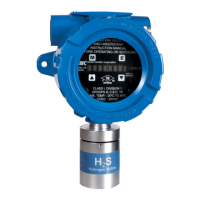2 Cautions & Warnings
2.1 Introduction
Although the IT Transmitter Modules are designed and constructed for installation and operation in industrial applications
including “hostile” environments, caution should be taken to ensure that the installation is made in compliance with this
instruction manual and that certain procedures and conditions are avoided. This chapter discusses the necessary cautions.
Read the entire chapter prior to installation of the equipment.
2.2 Gas Sensor Modules – General
Avoid installing sensor modules where they will be unnecessarily exposed to wind, dust, water (i.e. direct hose down),
shock, or vibration. Observe temperature range limitations.
Sensors may be adversely affected by prolonged exposure to certain materials. Loss of sensitivity, or corrosion, may be
gradual if such materials are present in low concentrations. These materials include: Halides (compounds containing
chlorine, fluorine, bromine, iodine), acid vapors, caustic liquids or mists.
Care has been taken by the manufacturer to ship modules in protective packaging to avoid contamination prior to
installation. It is recommended that the modules remain protected during installation and that the covering be removed
immediately prior to system start-up.
During normal use the O
2
, CO, and H
2
S sensors are protected from dirt and oil contamination by a sintered metal cover. If
this cover becomes clogged, the response of the sensor will be reduced. Protect the sensor from contamination by careful
placement, or by use of rain shields and dust shields.
Sensor modules must not be painted. Paint may contain compounds which will contaminate the sensor. Paint will cause
clogging of the sintered metal cover and will cause difficulties during attachment of the calibration head or other
maintenance activity. It is recommended that the module be tagged "DO NOT PAINT".
2.3 Wiring Warnings
The manufacturer recommends that extra caution be taken where the installation is near any sources of electromagnetic or
radio frequency interference. Precautions include:
• Avoid running sensor module cable close to high power cables, radio transmission lines, or cables subject to pulses of
high current.
• Avoid running cables near large electric motors or generators.
• When the sensor module is to be operated in analog (4-20mA output) mode shielded cable is required.
• When shielding is used, it is recommended that shields be grounded at the controller and nowhere else.
• All splices must be via either a termination hardware system or soldered. Improperly spliced cable can result in
corrosion, resistance changes and system errors. The use of wire nuts and crimp-on connectors is unacceptable.
NOTE:Installation and wiring must be in accordance with the National Electrical Code. Voltage AC conductors
are not to be run in the same conduit as voltage DC conductors.
2.4 Calibration Frequency
The H2S calibration frequency is six months or 180 days. However, prudent gas detector maintenance practices normally
suggest a simple recalibration following incidences of exposure to high levels of gas that would lead to alarm activation
within any system utilizing the output of the gas sensor module.
SMC 5100-XX-IT Toxic Gas Detector Module 11
US 2 Cautions & Warnings

